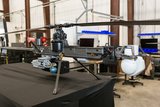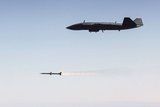First flight for Predator C
General Atomics Aeronautical Systems has announced the introduction of its next generation aircraft in the extremely successful Predator UAS series, Predator C Avenger.
The first flight of the new multi-mission jet-powered Avenger occurred on April 4 at the company’s Gray Butte Flight Operations Facility in Palmdale, CA with the aircraft landing without any discrepancies and ready to fly again once refueled.
Subsequent flights were successfully executed on April 13 and April 14, with the test program now ongoing.
“Following in the footsteps of the proven Predator B, Avenger adds yet another flexible and multi-mission capability to the Predator UAS series and is a testament to GA-ASI’s continuing practice of developing and delivering proven unmanned aircraft to military customers,” said Thomas J. Cassidy, Jr., president, Aircraft Systems Group, General Atomics Aeronautical Systems.
“Our company has been uniquely successful in forecasting military needs and delivering extremely capable unmanned aircraft that are ready for near-term military use. Just as the first two Predator B aircraft were developed and flown on IRAD [Internal Research and Development] funding because we saw the need for this type of capability, likewise, Avenger was developed through foresight and significant company investment provided by our Chairman and CEO, Neal Blue.”
Avenger was designed and developed with the intent of making a UAS that was more survivable in higher threat environments and to provide the US Air Force and other potential customers with an expanded quick-response armed reconnaissance capability. The aircraft will have higher operational and transit speeds than current Predator-series aircraft, resulting in fast response and rapid repositioning for improved mission flexibility and survivability.
Wide-area surveillance, armed reconnaissance, border surveillance, time-sensitive strike, and quick response capability missions for use against conventional and asymmetric threats (e.g., terrorists, pirates) are among its key missions.
Avenger’s new capabilities complement the operational flexibility of Predator/MQ-1 Predators and Predator B/MQ-9 Reapers by expanding the operational envelope of this series of aircraft. Predator/MQ-1 provides the high-flight endurance levels required on certain missions; Predator B/MQ-9 features a large weapons carriage capability, coupled with long endurance, as well as maritime surveillance; and now Predator C rounds out the flexibility of these aircraft systems with quick response armed reconnaissance.
Avenger presents a no risk/low-cost procurement option as it employs the same proven materials and avionics as Predator B and is controlled from and fully compatible with the standard GA-ASI Ground Control Stations (GCSs) used to control all Predator-series aircraft currently in use by US and allied military services. The aircraft is slightly larger than Predator B, incorporates a certified pure jet powerplant (Pratt & Whitney’s PW545B), and can carry the same mix of weapons as Predator B.
With a 41-foot long fuselage and 66-foot wingspan, Avenger is capable of flying at over 400 KTAS and can operate up to 60,000 feet. Aircraft sensors will include a GA-ASI Lynx Synthetic Aperture Radar (SAR) and various Electro-optical/Infrared (EO/IR) camera systems. A system based on Lockheed Martin’s F-35 FLIR is currently being evaluated, as well as an in-house full-motion video sensor. A pure reconnaissance version will be capable of carrying a wide-area surveillance system internally for special mission applications.
“Avenger further defines the level of technical innovation that American companies are capable of producing, and this kind of company initiative saves the government extensive amounts of money and development time while providing the war fighter with new combat systems quickly,” noted Cassidy. “This aircraft was designed, developed, and successfully flown while concurrently developing Sky Warrior® for the US Army, adding new capabilities to MQ-9 Reaper for the Air Force, and satisfying high-volume/accelerating orders for Predator-series UAS.”
More from Uncrewed Vehicles
-
![What's next for the Pentagon after the Replicator programme?]()
What's next for the Pentagon after the Replicator programme?
Although the Replicator initiative has made several accomplishments, there are still multiple gaps to plug across the US Department of Defense (DoD) and its services.
-
![Cummings Aerospace showcases Hellhound loitering munition designed for US Army’s LASSO programme (video)]()
Cummings Aerospace showcases Hellhound loitering munition designed for US Army’s LASSO programme (video)
Cummings Aerospace presented its turbojet-powered Hellhound loitering munition at SOF Week 2025, offering a man-portable solution aligned with the US Army’s LASSO requirements.
-
![SOF Week 2025: PDW unveils attritable FPV drone for SOF operations at scale]()
SOF Week 2025: PDW unveils attritable FPV drone for SOF operations at scale
PDW has revealed its Attritable Multirotor First Person View drone at SOF Week 2025, offering special operations forces a low-cost, rapidly deployable platform for strike and ISR missions, inspired by battlefield lessons from Ukraine.
-
![SOF Week 2025: Teledyne FLIR white paper provides guidance on reusable loitering munitions]()
SOF Week 2025: Teledyne FLIR white paper provides guidance on reusable loitering munitions
Teledyne FLIR is highlighting the emerging requirements for 'recoverable and re-usable' loitering munitions across the contemporary operating environment during this week’s SOF Week conference in Tampa, Florida.
-
![SOF Week 2025: Kraken Technology group debuts K3 Scout USV in North America]()
SOF Week 2025: Kraken Technology group debuts K3 Scout USV in North America
High-performance maritime industry player Kraken Technology Group, based in the UK, has used the SOF Week conference in Tampa, Florida this week to debut its K3 Scout uncrewed surface vessel (USV) to the North American market.
-
![Palladyne AI and Red Cat to demonstrate capabilities for autonomous drone swarms to the US military]()
Palladyne AI and Red Cat to demonstrate capabilities for autonomous drone swarms to the US military
Red Cat and Palladyne AI recently conducted a cross-platform collaborative flight involving three diverse heterogeneous drones.

























